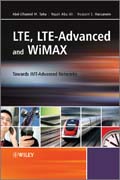
LTE, LTE-Advanced and WiMax: towards IMT-Advanced networks
Ali, Najah Abu
Taha, Abd-Elhamid M.
Hassanein, Hossam S.
A concise introduction to IMT-Advanced Systems, including LTE-Advanced and WiMAX There exists a strong demand for fully extending emerging Internet services, including collaborative applications and social networking, to the mobile and wireless domain. Delivering such services can be possible only through realizing broadband in the wireless. Two candidate technologies are currently competing in fulfilling the requirements for wireless broadband networks, WiMAX and LTE. At the moment, LTE and its future evolution LTE-Advanced are already gaining ground in terms of vendor and operator support. Whilst both technologiesshare certain attributes (utilizing Orthogonal Frequency Division Multiple Access (OFDMA) in downlink, accommodating smart antennas and full support for IP-switching, for example), they differ in others (including uplink technology, scheduling, frame structure and mobility support). Beyond technological merits, factors such as deployment readiness, ecosystem maturity and migration feasibility come to light when comparing the aptitude of the two technologies. LTE,LTE-Advanced and WiMAX: Towards IMT-Advanced Networks provides a concise, no-nonsense introduction to the two technologies, covering both interface and networking considerations. More critically, the book gives a multi-faceted comparison, carefully analyzing and distinguishing the characteristics of each technology and spanning both technical and economic merits. A big picture understanding of the market strategies and forecasts is also offered. Discusses and critically evaluates LTE, LTE-Advanced and WiMAX (Legacy and Advanced) Gives an overview of the principles and advances of each enabling technology Offers a feature-by-feature comparison between the candidate technologies Includes information which appeals to both industry practitioners and academics Provides an up-to-date report on market and industry status ÍNDICE: About the Authors Preface Acknowledgements List of Abbreviations 1Introduction 1.1 Evolution of Wireless Networks 1.2 Why IMT-Advanced 1.3 The ITU-R Requirements for IMT-Advanced Networks 1.3.1 Cell Spectral Efficiency 1.3.2 Peak Spectral Efficiency 1.3.3 Bandwidth 1.3.4 Cell Edge User Spectral Efficiency 1.3.5 Latency 1.3.6 Rates per Mobility Class 1.3.7 Handover Interruption Time 1.3.8 VoIP Capacity 1.3.9 Spectrum 1.4 IMT-Advanced Networks 1.4.1 LTE-Advanced 1.4.2 IEEE 802.16m 1.5 Book Overview References 2 Enabling Technologies for IMT-Advanced Networks 2.1 Multicarrier Modulation and Multiple Access 2.1.1 OFDM 2.1.2 OFDMA 2.1.3 SC-FDMA 2.2 Multiuser Diversity and Scheduling 2.3 Adaptive Coding and Modulation 2.4 Frequency Reuse 2.5 Wideband Transmissions 2.6 Multiple Antenna Techniques 2.7 Relaying 2.8 Femtocells 2.9 Coordinated Multi-Point (CoMP) Transmission 2.9.1 Interference Cancellation 2.9.2 Single Point Feedback/Single Point Reception 2.9.3 Multichannel Feedback/Single Point Reception 2.9.4 Multichannel Feedback/Multipoint Reception 2.9.5 Inter-Cell MIMO 2.10 Power Management 2.11 Inter-Technology Handovers References Part I WIMAX 3 WiMAX Networks 3.1 IEEE 802.16-2009 3.1.1 IEEE 802.16-2009 Air Interfaces3.1.2 Protocol Reference Model 3.2 IEEE 802.16m 3.2.1 IEEE 802.16m Air Interface 3.2.2 System Reference Model 3.3 Summary of Functionalities 3.3.1 Frame Structure 3.3.2 Network Entry 3.3.3 QoS and Bandwidth Reservation 3.3.4 MobilityManagement 3.3.5 Security 4 Frame Structure, Addressing and Identification 4.1 Frame Structure in IEEE 802.16-2009 4.1.1 TDD Frame Structure 4.1.2 FDD/HD-FDD Frame Structure 4.2 Frame Structure in IEEE 802.16j 4.2.1 Frame Structure in Transparent Relaying 4.2.2 Frame Structure in Non-Transparent Relaying 4.3 Frame Structure in IEEE 802.16m 4.3.1 Basic Frame Structure 4.3.2 Frame Structure Supporting IEEE 802.16-2009 Frames 4.4 Addressing and Connections Identification 4.4.1 Logical identifiers in IEEE 802.16-2009 4.4.2 Logical identifiers in IEEE 802.16j-2009 4.4.3 Logical identifiers in IEEE 802.16m 5 Network Entry, Initialization and Ranging 5.1 Networking Entry in IEEE 802.16-2009 5.1.1 Initial Ranging 5.1.2 Periodic Ranging 5.1.3 Periodic Ranging in OFDM 5.1.4 Periodic Ranging in OFDMA 5.2 Network Entry in IEEE 802.16j-2009 5.2.1 Initial Ranging 5.2.2 Periodic Ranging 5.3 Network Entry in IEEE 802.16m 6 Quality of Service and Bandwidth Reservation 6.1 QoS in IEEE 802.16-2009 6.1.1 QoS Performance Measures 6.1.2 Classification 6.1.3 Signaling Bandwidth Requests and Grants6.1.4 Bandwidth Allocation and Traffic Handling 6.2 Quality of Service in IEEE 802.16j 6.2.1 Classification 6.2.2 Signaling Bandwidth Requests and Grants 6.2.3 Bandwidth Allocation and Traffic Handling 6.3 QoS in IEEE 802.16m 6.3.1 QoS Parameters 6.3.2 Classification 6.3.3 Bandwidth Request and Grant 6.3.4 Bandwidth Allocation and Traffic Handling 7 Mobility Management 7.1 Mobility Management in IEEE 802.16-2009 7.1.1 Acquiring Ne
- ISBN: 978-0-470-74568-7
- Editorial: John Wiley & Sons
- Encuadernacion: Cartoné
- Páginas: 304
- Fecha Publicación: 28/10/2011
- Nº Volúmenes: 1
- Idioma: Inglés
